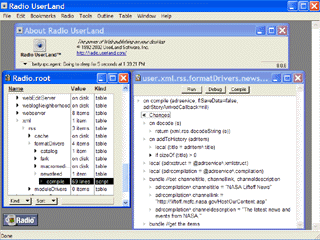|
Radio UserLand Kick Start: Extending Radio's Capabilities
This is part of Chapter 1 of the book
Radio UserLand Kick Start by Rogers Cadenhead, published by Sams Publishing
Radio.root is an object database stored in the main Radio UserLand folder that holds data and scripts that comprise the software's functionality. The source code for thousands of these scripts can be viewed by users, which helped my efforts considerably when I was learning to write my own UserTalk scripts.
Figure 1.3 shows the Radio application open with the object database in one window and the NASA format script in another.
Figure 1.3. Writing UserTalk scripts in Radio UserLand. (Enlarge)
To open the Radio application's graphical user interface on Windows, right-click the icon in the System tray and choose from the menu that appears.
On Macs, it automatically opens when the program is run.
To close it on Windows, close the application window. This doesn't shut down Radio; it just hides the interface.
To shut down Radio while using the application:
To shut it down anywhere else:
Caution: It's easy to inadvertently remove or alter items in the object database as you are learning to use it. Before exploring it in any detail or trying something adventurous, read Chapter 9, Backing Up Data. The script I wrote to read the LiftOff News XML file is called a format driver by UserLand, and it's one way among many that users can customize or extend the software.
When you know your way around the database, UserTalk language, and UserLand's Web sites, you can make Radio an more powerful tool for collecting or presenting information.
Chapter 1:
|
|
|
